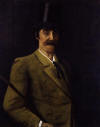100 Greatest Painters Artists Alphabetically Artists by Country Artists by Century Artists by Movement
1843-1903
American born British Tonalist Artist
One of the Greatest Painters Of All Time
Stylistically influenced by the following artists and movements - 18th Century Japanese Prints, Gustave Courbet, and Jean-Auguste-Dominique Ingres
Cause of Death - Heart Failure, he is buried at St Nicholas's Church in Chiswick, London.
Examples of tonalist paintings
James Whistler was an eccentric genius, who forged his own artistic path. The artist was a colorful and highly original personality who enjoyed his celebrity status to the hilt. Often parading about the streets of London sporting a flamboyant hat, dressed in a avant-garde suit that he designed himself, wearing a large diamond stickpin and a monocle. The painter was surrounded by the leading writers, artists, intellectuals and society dandies of the day. Whistler famously quipped "Art should be independent of all clap-trap – should stand alone, and appeal to the artistic sense of eye or ear, without confounding this with emotions entirely foreign to it, as devotion, pity, love, patriotism and the like."
Whistler became famous for his lavish dinner parties that unusually ended with several guests rushing out in tears. One of his best friends was the great English playwright, Oscar Wilde, with whom he traded barbs on a regular basis.
Characteristics of the Tonalism Painting Style and Technique
Tonalist style is rooted in the French Barbizon movement, which emphasized atmosphere and shadow. The unifying factor of the Tonalist style is a constrained palette and monochromatic color scheme. Whistler described the painting process "As light fades and the shadows deepen, all petty and exacting details vanish, everything trivial disappears, and I see things as they are in great strong masses: the buttons are lost, but the sitter remains; the sitter is lost, but the shadow remains; the shadow is lost, but the picture remains. And that, night cannot efface from the painter's imagination."
The interiors of Tonalist paintings are generally elegant and sparsely decorated, tonally uniform, simplified and indistinct; the figures are usually presented alone in silent contemplation. Landscapes are typically luscious and luminous with evocative atmospheric effects featuring misty backgrounds illuminated by moonlight. Tonalist painters were drawn to both the natural and spiritual realms. They sought to awaken the viewers consciousness by shrouding the subject in a misty indistinct veil of emotionalism. The palette is minimal, characterized by warm hues of brown, soft greens, gauzy yellows and muted grays. Preferred themes were evocative moonlight nights and poetic, vaporous landscapes. Tonalist painters seemed to favored unconscious states and psychological experiences over reality.
Descptive art words and phrases associated with Whistler's tonalist style - obscured details, single-figure themes, the natural and spiritual domain, waking, monochromatic , sleep, dreams, death, aura, religious implication, emotionalism, emotionalists, pictorial space, compositional space, diffused light, incandescent glow, organic forms, artistic inspiration, illusionist representation, luminous, transcendentalist, glowing, metaphysical, sensitive expression, poetic, evocative
Popular Questions About Art History
What
was the impact of Japanese
Prints on Post Immpressionist painters in the late 19th
century?
What role did Entartete
Kunst play in 20th cetury art?
How did the Black Death impact European art history?
How did the Inquisition impact European art history?
What was the influence of the Medici Academy on Renaissance painters?
How did the Bonfire of the Vanities impact Italian Renaissance?
☼☼☼☼☼
If you feel you have worthwhile information you would like to contribute we would love to hear from you. We collect essential biographical information and artist quotes from folks all over the globe and appreciate your participation. When submitting please, if possible, site the source and provide English translation. Email to historyofpainter@gmail.com
© HistoryofPainters.com 2017
This text is Copyright © historyofpainters.com. Do not use without permission. If you like this page and wish to share it, you are welcome to link to it, with our thanks.

